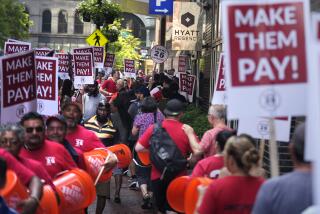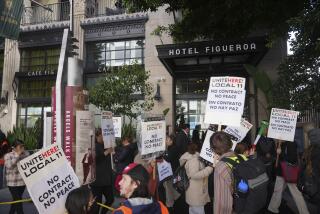Where Have the Tourists Gone? : Hotels: As occupancy rates hover in the âred flagâ range, operators are lowering room rates to lure vacationers.
Too many hotels and intense competition for too few tourists have triggered a major shakeout in the Orange County hotel business, leaving behind a trail of financial failures and the prospect of an uncertain future for a pillar of the local tourism industry.
Since the current recession began two years ago, at least 13 large hotels have ended up either in foreclosure, receivership or bankruptcy, including the swank Hyatt Newporter in Newport Beach.
Hotel occupancy is off, and an estimated 1,450 hotel workers--about 7% of all lodging employees on the job at the industryâs peak in 1989--are now out of a job.
The value of hotel and resort property has plummeted over the past two years, and at least five proposals to build major hotels are now stalled, frustrating ambitious plans to turn the coast between Huntington Beach and Dana Point into the Orange Riviera.
Despite some signs of a modest recovery and reports of increased bookings since May, hotel analysts say the situation might just worsen before it gets better. They caution that if current room rate discounting persists for the rest of the year, it could force more properties into foreclosure, particularly hotels built since 1985 that are heavily in debt and expensive to operate.
âThe impact of the 1990-1991 recession has been very drastic,â said Esmael Adibi, director of the Center for Economic Research at Chapman University in Orange. âIn the 1981-82 recession, total employment went down, but the tourist industry did not show negative growth and did not lose any jobs. But this recession is different.â
Industry experts say the Orange County hotel business has been battered during the past two to three years by the Gulf War, a nagging recession and the Los Angeles riots, as well as chronic overbuilding that more than doubled the number of first-class hotel rooms in Orange County in the past decade.
Around John Wayne Airport alone, the number of rooms increased from 2,700 in 1980 to about 8,000 in 1990, according to Jim Burba, a lodging analyst based in Monarch Beach. The figure does not include motel rooms.
As the recession kicked in, the new hotels simply cannibalized the profits of their competitors down the street as a dwindling number of guests were spread among more and more rooms.
Consequently, the average hotel occupancy rate in Orange County fell from 66.8% in 1989 to 58.9% for the first three months of 1992, according to the latest available statistics from Smith Travel Research, a national consulting firm. The decline from 1991 to the first quarter of 1992 was 2.2%.
âToday, the industryâs average occupancy is in the low 60s,â said Joseph J. Doyle, a lodging analyst and managing director at Smith Barney. âThe bell shape of the curve, of course, means there are a lot of hotels in the 50s with varying degrees of financial loss. Occupancy in that range is a red flag.â
Declining occupancy, combined with cuts in room rates, have reduced hotel profits and the value of resort properties throughout Southern California.
Hospitality Valuation Services, a New York-based consulting firm that specializes in appraising hotel properties, estimates that the value of a typical hotel in the Anaheim area fell more than 30% from 1989 to 1991. The decline for 1991 alone was 20%.
Nationally, the value of a typical hotel fell about 14% in 1991. When combined with the previous yearâs drop, the value of hotels across the country has dropped on average about 18%, compared to the more than 30% decline here.
Stephen Rushmore, an expert in resort appraisals and president of Hospitality Valuation, concluded that the declining values have effectively wiped out the investorsâ equity in many hotel projects.
âThe nation is pretty much at the bottom right now, but California is lagging behind the rest of the country,â Rushmore said. âI would anticipate another year or two of declining values in the Los Angeles-Orange County area.â
Surviving hotels are now trying to cope by aggressively promoting themselves, cutting room rates, and adding amenities in an attempt to book more business travelers and summer vacationers.
So-called ârack pricesâ at major hotel chains have been cut anywhere from 10% to 50% a night, sometimes more. The Irvine Marriott recently lowered its rate to $49 a night, a $90 discount, as long as reservations are made 21 days in advance.
The Surf and Sand Hotel in Laguna Beach has offered free tickets to the Pageant of the Masters and a âRomantic Packageâ with dinner served on the room balcony and breakfast in bed.
Even the upscale Ritz-Carlton in Dana Point, known for impeccable service and such amenities as phone-equipped commodes, is throwing in special packages that include free green fees and fitness programs.
But market analysts say that if the discounting continues for a long period, it could trigger another round of economic woes, particularly for recently built hotels that were expensive to build.
âWith the overbuilt situation and the recession, the only competitive advantage is rate,â said Donald W. Wise, an expert in lodging and hospitality properties with CB Commercial-Investment Banking Group in Anaheim. âNeedless to say, it could be suicide if it goes on long enough.â
The hotel industry nationwide lost about $6 billion last year, Wise said, and at least 60% of hotels across the country were having difficulty servicing their debt. He estimated that about 2,000 hotels were foreclosed on in the last 24 months and that another 2,000 properties could to go back to the lender or be foreclosed on in the next 36 months. This represents about 9% to 12% of the roughly 42,000 domestically owned hotels in the United States.
âRegrettably, we are facing these same problems in Orange County. We still have a ways to go,â Wise said.
The recession too has stymied at least five major hotel projects--three in Huntington Beach and two along the Irvine Coast, which have been put on hold until the market improves and financing is found.
Perhaps the only major hotel with any potential of being built soon is the 400-room Monarch Beach Resort in Dana Point, across Coast Highway from the Ritz-Carlton. Ben Cagle, a spokesman for the project, said Monarch Beach is still going through the approval process and the developer is trying to obtain financing.
âIt is safe to say, we wonât see the rate of increase of the 1980s as we go through the first part of the 1990s,â lodging analyst Burba said.
More to Read
Inside the business of entertainment
The Wide Shot brings you news, analysis and insights on everything from streaming wars to production â and what it all means for the future.
You may occasionally receive promotional content from the Los Angeles Times.











